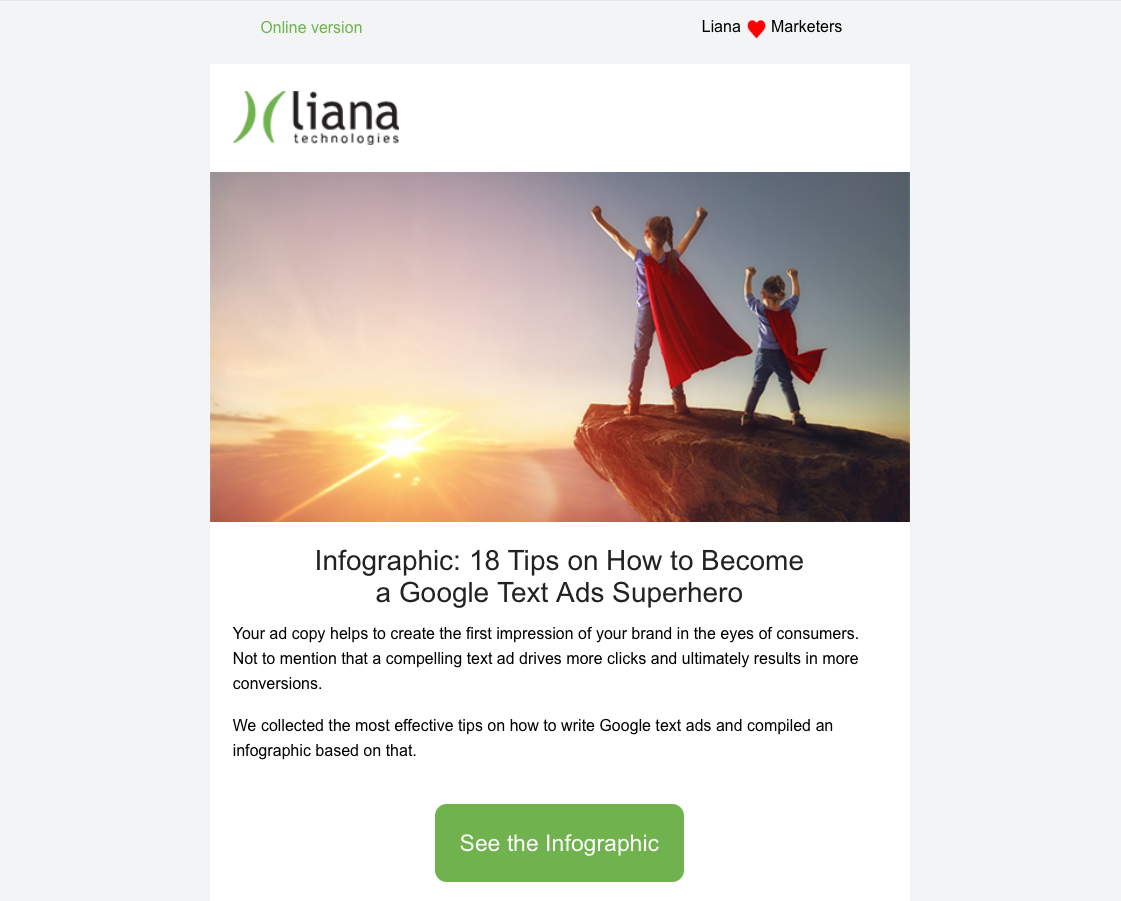Great content for your newsletter is literally everywhere – you just have to learn how to spot it and put it into use!
Why make the effort? Because newsletter is an effective, personal and measurable way of communication and a trusted companion in both B2C and B2B marketing and communications. And, as you have heard at least a million times before: it DOES have the best ROI of all marketing channels.
Newsletter combined with engaging content results in readers that create value for your organization – be it in monetary value or in a way that is valuable to you otherwise.
Email is also at the top of the type of content people want to receive from brands. But, on average, people receive about 90 emails per day. Standing out is a tough job and the means to do it are plentiful.
How to come up with content for email marketing?
Whatever your field of expertise is, content for your newsletters can be found within your industry’s phenomena, with your personnel, from your customers and other stakeholders, in the events of your field, and it should aim to get your readers to interact with your organization.
You can also find content through:
- Googling
- Benchmarking
- Google keyword search
- Media monitoring
- Google trends etc.
Content suggestions for emails
1. Informative or educational content
People’s time is valuable, and you should in turn value the chance you’ve gotten with people that read your content. Whatever your field is, try to approach your subject from different angles and offer your readers different perspectives on an issue.
Write articles in a lighter tone and add a lot of illustrative images. Utilize infographics. Every once in awhile drop a colossal article that digs in as deep as possible in a subject.

Liana Technologies utilizes infographics in support of and to sum up articles. Infographics are a great way to get traffic from your newsletters to your blog or your site.
On one hand the trend nowadays is definitely towards shorter newsletters but on the other hand, your readers might be in the field of legal, for example, and appreciate a thorough explanation of whatever is at hand.
Long or short, make sure to add a chosen few short inserts in your newsletter, and make it easy to read more on the website or a landing page. The newsletter is the incentive to go further into your content.
If you write a blog on your website or have a news section that you would like to have included in your newsletter, this can be easily done with an RSS feed. The feed is automatically imported into your newsletter. For the marketer who struggles with lack of time, an RSS feed is a blessing.
Videos are great for education content. Read more on how to get started with videos!
2. Customer cases or employee stories
One of your greatest assets are the stories you can tell about your customers – even better if you can include hard facts and figures. If your customer cases or employee stories tend to be written articles, why not mix it up at times and make them in video or infographic format instead. “Infographic: How XX went from intern to Head of Department in 7 years”.
If the target group of your emails is, for instance, potential employees instead of customers, employee stories are a great way to engage people.
3. Insights from the company or the industry
Your organization is full of experts. Give them the arena to talk about their line of work. The faces behind your company bring you closer to the people. Tip! Invest in professional video equipment and have an expert explain to the camera instead of you for writing it down, or simply sit them down on a couch with you and keep the cameras rolling.
4. Challenges
It is not always fun and games in anyone’s business. Telling about the challenges that have up along the way make you more relatable since everyone encounters tribulations at some point. Your newsletter is a great platform for you to spread your wisdom about how you overcame a difficult situation. How about doing “Our 5 best failures of 2019” compilation at end the year?
5. Expos and events
Expos and events are important ways of keeping up what is going on with the industry, but not everyone can make it. Save their time and tell them what you learned. Recaps of your own events or participating in your industry's expo or other event are great content for your newsletter. You can showcase that you are an active member in your field and grow your expert status. Include real pictures and little video clips.
6. Other types
Don’t forget these either:
- Promotion letters
- Communications letters that focus on brand building and making the customer committed
- News and current issues
- Gathering donations
- Lead generation and nurturing
- Welcoming new customers and getting them acquainted with the company
- User guidance to products
- Event invitations
- Activating messages for passive customers
- Rewarding loyal customers
- Remembering customers (birthdays, etc.)
- Competitions
- Seasonal greetings
Things to take into account when creating a newsletter
1. Interactivity
The open rates of your newsletter are no longer the most important metric for you. They do tell you that your newsletter was looked at but more important is that you know you made an impact, right?
You want to evoke an action from the reader. This is the true value in your content so that these people keep on reading your newsletters in the future as well.
Interactivity is currently one of the biggest trends in content. This is because it simply makes the reader more engaged with the content.
What makes interactivity so desirable: engagement means there is a relationship being built, which means there is trust which ultimately means good business for you.
Interactive content can be, for example:
- Polls
- Surveys
- Moving images that have multiple links for different content
- Videos
With the absolute triumph of mobile, people have become to expect app-like interactivity from other media as well. Static content needs to truly validate itself for the reader by being right up their alley – such as legal or other industry-specific text that the reader is expecting.
Otherwise, you are losing a ton of opportunities if you are not utilizing interactivity to engage your readers.
2. CTA
Because it’s interactivity that you want, your Call-to-Action is more important than ever. Have clearly separated sections in your newsletter with clearly separate CTAs. In fact, having one theme per newsletter and one clear CTA for this theme is advisable. When you have one thing in mind that you want people to act on, it makes it that much easier for you and also your reader.
A coherent email is easy to read and its different parts form a logical entity – if the letter has too many different themes, the newsletter easily becomes confusing.
3. Accessibility
Accessibility is one of the hottest topics in the digital world today. The international WCAG (Web Content Accessibility Guidelines) and the EU directive about web accessibility have raised the profile of this issue.
All this concerns newsletter templates too. Therefore, keep in mind that your newsletter shouldn’t be too outside the box that people can’t navigate what to find and where. Don’t have seizure-inducing blinking in your gifs. Use colors and contrasts that are visible for the visually impaired too.
4. Scannability
The scannability of a newsletter pays off since the reader rarely has the possibility to concentrate on every word in a newsletter. Scannability means that it's easy to pick up on the main themes and see the different sections in the content. The same scannability should be remembered when writing blogs because a long text without sections numbs the readers.
Newsletter's scannability is enhanced by:
- Covering a theme per section
- Bullets and/or numbers
- Clear distinction between sections
- Using succinct instead of lengthy sentences
- Visual highlighting (colors, fonts, CTA, links)
- Evoke emotions: Entertain and convince
When creating content for newsletters, remember that at the other end there's another human being reading the letter. Just like you, this person wants to be entertained. Evoking emotions is not always easy but it's worthwhile to give some time and thought.
In addition to being fun and providing content that has character, also remember to convince your readers. What help you to be convincing are once again numbers, checked facts and, for example, that a third party elaborates on the subject (e.g. references and customer reviews). In the best-case scenario, the third party is the kind the reader can relate to (e.g. a colleague) or someone whose opinion is especially valuable, like an expert in the field.
5. Focus on the recipient, not yourself
Even good content can provoke a backlash in the reader if it feels too much like bragging or pushing. A good rule of thumb is to aim for showing the benefits for the reader and seeing things from the reader's point of view. Simply put, it's about telling the readers how they will benefit or how they will be affected instead of going on about what "we have" or what "we did". If the aforementioned point of view is hard to find, it's good to review whether the planned content is relevant for the recipient in the first place.
One thing is for sure: even though you might feel stuck in a rut, you will not run out of content – ever. You maybe have to boldly go where you haven’t gone before and find a new approach to making content. If you are running out of time or hands, you might also want to consider automating at least a part of your content.




![How to Get Started with Podcasts? [Infographic]](/media/blog/podcast-article/cache/starting-your-own-podcast-article-cover-378x214,c.png)